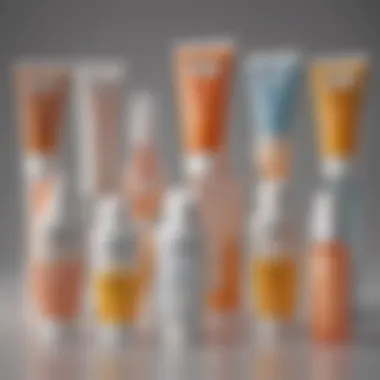Mineral vs Chemical Sunscreen for the Face: Key Insights


Intro
Sunscreen is a vital component of any skincare routine, especially for protecting the delicate skin on the face. Understanding the differences between mineral and chemical sunscreens can make a significant difference in selecting the right product. This comprehensive analysis explores various aspects of both types, dissecting their ingredients, effectiveness, and suitability based on individual skin types. Together, we will navigate common misconceptions that surround these sunscreens, explore their environmental implications, and consider regulatory frameworks that dictate their safety and efficacy.
In an age where skincare is increasingly scrutinized, the choice between mineral and chemical sunscreen becomes more than just personal preference—it embodies a deeper understanding of skin health and environmental consciousness. Addressing this complex landscape will equip readers with the tools they need to make informed, suitable decisions in their sun protection practices, reflecting each person's unique skin demands and lifestyle needs.
Both mineral and chemical formulations have their advocates. These advocates claim various benefits and drawbacks. Let's embark on this fascinating journey to discern which sunscreen aligns best with your skin's requirements.
Understanding Sunscreen
Understanding sunscreen is crucial for anyone who desires to protect their skin from harmful ultraviolet (UV) rays. This topic lays the foundation for discussing the specific types of sunscreens available in the market, particularly mineral and chemical varieties. By grasping what sunscreen is and why sun protection matters, consumers are equipped to make informed choices about their skincare regimens.
What Is Sunscreen?
Sunscreen is a topical product designed to absorb or reflect UV radiation from the sun. It's formulated with several active ingredients that help protect skin. Sunscreens are essential in blocking both UVA and UVB rays, which can cause skin damage, impede cellular repair, and lead to skin cancers. In some formulations, minerals like zinc oxide and titanium dioxide serve as physical blockers, while chemical filters such as avobenzone and octisalate absorb UV light.
The Importance of Sun Protection
Protecting the skin from sun damage is vital for several reasons:
- Prevention of Skin Cancer: UV radiation is a leading cause of skin cancers, including melanoma. Using sunscreen regularly significantly reduces risk.
- Reduction in Premature Aging: Sun exposure causes premature skin aging, manifesting as wrinkles, fine lines, and age spots.
- Skin Tone Evenness: Sunscreen helps prevent uneven pigmentation patterns, which may occur due to sun exposure.
- Improved Skin Health: A good sun protection routine can maintain skin hydration balance and prevent post-inflammatory pigmentation issues.
Regular use of sunscreen decreases the likelihood of developing squamous cell carcinoma by about 40% and cutting the melanoma risk by 50%
Understanding these facets of sunscreen provides a clear context for both mineral and chemical options. It also allows consumers to assess their particular needs based on lifestyle, sensitivities, and preferences.
Overview of Mineral Sunscreen
Understanding mineral sunscreen provides essential insights that help consumers make informed decisions about their skincare. Mineral sunscreens, often preferred for their physical barrier approach, utilize specific ingredients that engage directly with UV radiation to protect the skin. This section seeks to outline vital aspects, benefits, and considerations related to mineral sunscreens.
Key Ingredients in Mineral Sunscreen
Mineral sunscreens typically contain two primary ingredients: zinc oxide and titanium dioxide.
- Zinc Oxide: This ingredient is well-known for its strong broad-spectrum protection. It reflects both UVA and UVB rays, which makes it very effective.
- Titanium Dioxide: This offers effective UVB protection and also some UVA shielding. It often accompanies zinc oxide to enhance overall sun protection.


Both these ingredients have a long history of safe usage and are preferred by dermatologists, particularly for sensitive skin types.
How Mineral Sunscreens Work
Mineral sunscreens work by creating a physical barrier on the skin's surface. When applied, they sit atop the skin rather than being absorbed. This layer reflects and scatters harmful solar radiation away from the skin. As a result, mineral sunscreens provide immediate protection once applied, unlike some chemical formulations that require time for absorption.
It is significant to note that while they are effective upon application, reapplication is still necessary, especially after sweating or swimming.
Benefits of Mineral Sunscreen
The advantages of mineral sunscreen make it a favorite among many. Some key benefits include:
- Immediate Protection: Unlike chemical sunscreens, mineral formulations protect instantly upon application..
- Broad-Spectrum Coverage: Effective against both UVA and UVB rays.
- Lower Risk of Irritation: Typically, mineral sunscreens are gentler, making them excellent for sensitive skin, including that of children and those with conditions like rosacea.
- Eco-Friendly: With a shift towards sustainable practices, many mineral sunscreens avoid harmful ingredients for both oceans and reefs, making them more environmentally friendly compared to some chemical counterparts.
Potential Drawbacks of Mineral Sunscreens
Despite their many benefits, it's important to be aware of some potential drawbacks. These include:
- White Cast: Mineral sunscreens can leave a visible white residue, making them less desirable for people with darker skin tones.
- Thicker Texture: They can sometimes feel heavy or greasy on the skin compared to lighter chemical options.
- Less Efficient in Water Resistance: While there are water-resistant mineral sunscreens, they may not provide the same efficacy as certain chemical formulations designed for prolonged water exposure.
Overview of Chemical Sunscreen
Understanding chemical sunscreen is crucial in making informed choices about facial skincare. This type of sunscreen typically uses organic compounds to absorb UV radiation and convert it into heat, which is then released from the skin. Knowing how it differs from mineral options will help readers determine what works best for their individual skin types and lifestyles. Moreover, the characteristic ingredients and mechanisms presented in these formulations offer significant insights into their effectiveness, ease of use, and overall impact on skin health.
Key Ingredients in Chemical Sunscreen
Chemical sunscreens often consist of several key ingredients. Some common ones include oxybenzone, avobenzone, octisalate, octocrylene, and homosalate. These components utilize different strategies to filter out various UV rays.
- Oxybenzone: Effective against both UVA and UVB rays but may raise concerns regarding skin absorption.
- Avobenzone: Specifically targets UVA rays and provides prolonged protection breaking down faster than some other chemicals.
- Octinoxate, Octisalate, and Homosalate: These ingredients primarily shield against UVB rays and are often mixed for a broader range of protection.
- Octocrylene: Helps stabilize other ingredients, ensuring the sunscreen remains effective over time.
Choosing chemical sunscreen involves understanding how these actives interact with the skin.
How Chemical Sunscreens Work
Chemical sunscreens employ a process of absorption of UV radiation. When applied to the skin, the organic compounds react with UV rays, transforming them into heat and preventing them from penetrating deeper layers. This property means that they often have a lighter feel than mineral options and can go seamlessly under makeup. The process is fast-acting but tends to require some time for an optimal effect, usually around fifteen minutes before sun exposure.


Benefits of Chemical Sunscreen
The advantages of chemical sunscreens can appeal to many users, including:
- Cosmetic Elegance: Typically, these sunscreens are less visible on the skin, making them appealing for everyday use.
- Variety of Formulations: They come in various sorts, from non-greasy gel lotions to lightweight sprays, providing several options for all skin types.
- Ease of Application: They spread easily, following typical skincare routines without too much effort or additional texture.
- Effectiveness Against UVB Rays: chemical sunscreens often offer broad-spectrum protection, especially against UVB rays, which are responsible for sunburn.
Potential Drawbacks of Chemical Sunscreens
Despite the perks, chemical sunscreens also present some significant drawbacks that may warrant consideration:
- Sensitivity or Allergy Risk: Some individuals may experience irritations or allergic reactions to certain chemical compounds.
- Reapplication Needs: Some formulations may require more frequent application, especially after swimming or sweating, due to their chemical nature breaking down when exposed to moisture.
- Environmental Impacts: Certain ingredients, like oxybenzone, have been flagged for potentially harming coral reefs and marine ecosystems, drawing attention and criticism.
The choice between chemical and mineral options comes with its own set of various weights, and understanding these factors aids informed decision-making.
Comparative Analysis of Mineral and Chemical Sunscreens
Understanding the comparative analysis between mineral and chemical sunscreens is crucial in selecting the right option for facial skin. This comparison sheds light on specific elements that influence effectiveness, skin compatibility, application, and longevity of protection. By examining both types side by side, consumers can make informed choices that align with their skin type, lifestyle, and ethical beliefs.
Effectiveness in UV Protection
Effectiveness in UV protection is one of the primary concerns when choosing sunscreen. Mineral sunscreens, which typically contain zinc oxide and titanium dioxide, work by sitting on the skin's surface and reflecting harmful UV rays. They offer broad-spectrum protection, shielding against both UVA and UVB rays. On the other hand, chemical sunscreens absorb UV radiation through their chemical ingredients such as oxybenzone, avobenzone, and octisalate, converting it into heat and then releasing it from the skin. While both types are designed to prevent sunburn and skin damage, studies indicate that mineral sunscreens provide more immediate protection upon application, whereas chemical options require about 20 minutes of absorption time before effectiveness begins.
Skin Compatibility and Sensitivity
Skin compatibility is essential for individuals with delicate skin or conditions such as rosacea and eczema. Mineral sunscreens are often deemed less irritating since their natural ingredients are less likely to cause allergic reactions. Their formulation typically avoids synthetic chemicals that can be harsh on vulnerable skin types. Conversely, chemical sunscreens can sometimes provoke irritation or worsen skin conditions. There is ongoing debate and research about the long-term impact of certain chemical ingredients, which brings additional consideration for those generally prone to sensitivities. Therefore, individual skin tests are advisable, especially when using a new product.
Application and Wearability
The method of application and overall wearability are significant during daily usage. Mineral sunscreens tend to leave a white cast due to their opaque particles, which can be particularly noticeable on darker skin tones. However, many brands have worked on formulations that reduce this effect. Chemical sunscreens usually offer a more translucent application and might feel lighter on the skin, appealing to those who dislike the feel of traditional sunscreen. On the downside, the need for careful application around the eye area is elevated with chemical sunscreens, given the potential for stinging when they migrate into the eyes. It is essential for users to choose based on comfort as well as physical appearance.
Longevity of Protection
Longevity of protection refers to how long a sunscreen can maintain its effectiveness. Mineral sunscreens typically provide longer-lasting protection than chemical formulas, resisting degradation more effectively when exposed to sunlight. They are less likely to break down in heat, providing a dependable shield throughout activities such as swimming or sports. Chemical options, while effective, may require more frequent reapplication, particularly after water exposure or excessive sweating. Therefore, understanding individual use scenarios will help consumers decide how frequently they need to reapply their chosen sunscreen.
Choosing the best option requires a balance between personal needs, lifestyle, and product expectations.


Environmental Considerations
Understanding the environmental ramifications of sunscreens adds an important layer to the choice between mineral and chemical options. They both contribute to personal skincare, but their broader impacts are significant and cannot be overlooked. This section highlights these factors in detail, presenting a clearer picture of how our sunscreen choices influence the health of the planet.
Impact of Ingredients on Marine Life
Chemical sunscreens often contain specific ingredients, like oxybenzone and octinoxate, which have been linked to coral reef damage. Studies have shown that these chemicals can cause coral bleaching, compromising marine ecosystems. This is especially concerned in locations where sunscreen washes off into the ocean.
- Coral Reef Degradation: The coral reefs serve as critical marine habitats. They provide shelter and sustenance to various marine species. When chemical ingredients seep into marine waters, they hinder the coral's ability to reproduce.
- Toxicity to Marine Life: Some sunscreen chemicals can accumulate in marine organisms, leading to changes in fish populations and overall biodiversity. The potential toxic effects on the reproductive systems of various sea creatures highlight the urgency of finding alternatives.
- Legislation Changes: Due to growing awareness, some regions are implementing bans on certain harmful sunscreen ingredients to protect marine environments, urging consumers to choose reef-safe options. Using mineral sunscreens, like those with zinc oxide and titanium dioxide, present a safer route since they do not contribute to these environmental issues.
It is essential to consider the impact of sunscreen on marine ecosystems to promote sustainable skincare practices.
Sustainability in Sunscreen Production
The production processes behind sunscreens also require attention. Sustainability refers not only to the ingredients but also to how they are sourced and manufactured.
- Sourcing Ingredients: Mineral sunscreens typically use naturally derived ingredients. Opting for brands that emphasize ethical sourcing helps to mitigate negative ecological impacts. Look for products that gather minerals in sustainable ways.
- Manufacturing Processes: The environmental impact of producing sunscreen also hinges on factory operations. Brands that use biodegradable and non-toxic materials during production lessen overall harm to nature.
- Packaging Decisions: Eco-friendliness extends to the product packaging. Companies that choose recyclable or biodegradable materials are making responsible choices. This can significantly impact waste produced by traditional plastic containers.
Using sustainable sunscreens not only benefits your skin but encourages more responsible manufacturing globally. Choosing mindfully, looking for eco-certifications and following trends in greener practices can shift the industry towards better environmental stewardship.
Regulatory Guidelines and Labeling
Regulatory guidelines and proper labeling are crucial for informed choice in the use of sunscreens. Consumers need clear and reliable information about what they apply to their skin. This significance transcends mere marketing; it impacts health and environmental safety as selecting the right product. Understanding these guidelines can aid individuals in selecting sunscreens that best suit their specific needs, especially when navigating the dual realms of mineral and chemical formulations.
Understanding SPF Ratings
Sun Protection Factor (SPF) is a commonly referenced term when discussing sunscreen, yet misconceptions persist around what it represents. SPF indicates the level of protection against UVB rays, which are primarily responsible for sunburn and can contribute to skin cancer.
- SPF Indicator: An SPF of 15 blocks approximately 93% of UVB rays, while SPF 30 blocks about 97%. Higher SPF ratings give little additional protection, underscoring that more does not equate to substantially better protection.
- Broad Spectrum: Sunscreens labeled as
The End
The choice between mineral and chemical sunscreens is a pivotal aspect of skincare, particularly for the face, where skin sensitivity and common conditions like acne can arise. Understanding the essentials from composition to environmental impacts is crucial. By gaining insight into both options, consumers can make informed decisions suited for their personal skin preferences.
One significant factor that plays into the debate is the ingredients present in these products. Mineral sunscreens, typically containing zinc oxide or titanium dioxide, act as physical barriers on the skin's surface. In contrast, chemical sunscreens use absorptive compounds that penetrate the skin layers to block UV rays. This distinction not only dictates how each type functions but also has implications for application and wearability.
When considering skin compatibility, both types have their merits. Mineral sunscreens are often recommended for sensitive skin due to their gentle nature, while chemical options may trigger reactions in some individuals. This leads to an essential consideration of personal skin type in the choice of sunscreen. By doing patch tests and understanding one's own sensitivities, buyers can better judge which product is fitting.
“Sunscreen should always correspond with your skin’s needs and sensitivities.”
Furthermore, the issue of environmental impact cannot be overlooked. Recent discussions have heightened awareness regarding the influence of certain chemical ingredients on marine ecosystems. Opting for sunscreens marked as reef-safe can align consumers’ choices with sustainability priorities.















